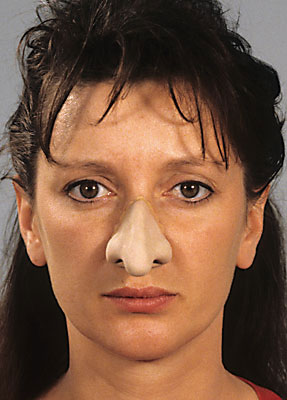Apply a little Grimas Mastix Extra to the inside of the scales/adhesive edge and allow it to dry for a few seconds. Do the following to get the correct degree of adhesion: press the latex prostetic lightly in place and then remove it again straight away. Wait a few seconds and reposition the application, pressing the edges in place with a tissue.
Protect the eyes by closing them and covering them with a tissue. Can cause serious damage to the eyes.
To get a smooth transition between the latex prostetic and the skin, even the edges off as follows: apply a thin line of eyelash adhesive to the edge of a sponge and dab this over the transition between the latex prostetic and the skin. Allow to dry with help of a hairdryer until the result is transparent. Repeat this process until a nice and even transition is obtained. Colour the edges of the transition with the colour being used.
Powder it all off with Grimas Transparent Powder or Fixing Powder and then remove any excess powder.
















